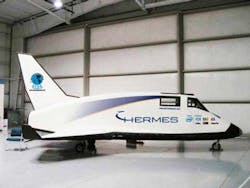Commercial Space Travel Gets Controls Boost
Aug. 4, 2011
3 min read
Built on the premise that anyone who wants to should be able to take a trip into space, the Hermes Spacecraft is a space shuttle for everybody, according to Star Systems founder Morris Jarvis (who also happens to be modeling project manager at Intel in Chandler, AZ).
Before anyone can take a sub-orbital trip on the Hermes spacecraft, however, the craft’s control systems must be developed and tested. That’s where National Instruments enters the picture.
NI’s PXI controller is used to connect the craft’s actuators to the control surfaces (tail rudder and wing flaps) they’ll be used to move. PXI controllers are also used for managing all digital sensor and instrument I/O on the craft.
LabVIEW virtual instruments are a key component of the human-machine interface touchscreens in the Hermes cockpit to integrate control of the craft’s subsystems and respond to anomalies. In addition to its HMI use, LabVIEW is also being used in the start/stop testing of the Hermes engine now under development.
Bringing space to the people
When it comes to bringing space flight to non-astronauts, Jarvis’ plan runs along similar lines to that of Richard Branson and his Virgin Galactic project. The difference is that Jarvis intends to make the trip more affordable. Initial cost projections for a sub-orbital trip on the Hermes spacecraft will range from $40,000 to $150,000, whereas a flight on Virgin Galactic’s SpaceshipTwo is expected to run $200,000.
The first type of space adventure on Hermes that Star Systems is planning for will be launched via an ultra-high helium research balloon. As many as 5 passengers will be carried up to 113,000 feet (21.4 miles) above the Earth, at which time Hermes will be detached from the balloon and flow back to Earth like an airplane. The per-passenger fare for the balloon excursions is expected to be about $40,000.
Morris also plans to offer a rocket-launched trip as well, taking passengers 70 miles above the Earth for a 15-minute weightless experience. Like the NASA space shuttle, Hermes will be launched with a turbine-powered first-stage booster rocket and landed much like an airplane. These rocket-launched trips will seat up to six passengers and will likely cost each traveler approximately $150,000.
Following is the current timeline of milestones driving development of Hermes:
- Late 2011 Milestone #1: Unmanned, Tethered Flights
Hermes’ first flight will be an unmanned, tethered adventure over a remote location in Arizona. Morris will control the spacecraft from a remote cockpit on the ground. We'll conduct more tethered flights as needed to ensure Hermes is performing as expected. - Early 2012 Milestone #2: Manned, Airplane-Type Flights
Several months after the tethered flights, Hermes will be equipped with engine pods so it can be flown like an airplane. These flights will be manned by experienced pilots. - Late 2012 Milestone #3: Unmanned Flight Dropped from a High–Altitude Balloon
After the success of the tethered and un-tethered ground-based flights, Hermes will be towed to an altitude of 113,000 feet by an ultra-high altitude helium research balloon, then flown back to Earth. - Early 2013 Milestone #4: Complete Flight Profile
Using data from all of the various test flights, the production version of the space-traveling Hermes will be manufactured, complete with the appropriate heat shield necessary for re-entry into the Earth’s atmosphere.
About the Author
David Greenfield, editor in chief
Editor in Chief
David Greenfield joined Automation World in June 2011. Bringing a wealth of industry knowledge and media experience to his position, David’s contributions can be found in AW’s print and online editions and custom projects. Earlier in his career, David was Editorial Director of Design News at UBM Electronics, and prior to joining UBM, he was Editorial Director of Control Engineering at Reed Business Information, where he also worked on Manufacturing Business Technology as Publisher.
Sign up for our eNewsletters
Get the latest news and updates

Leaders relevant to this article:
